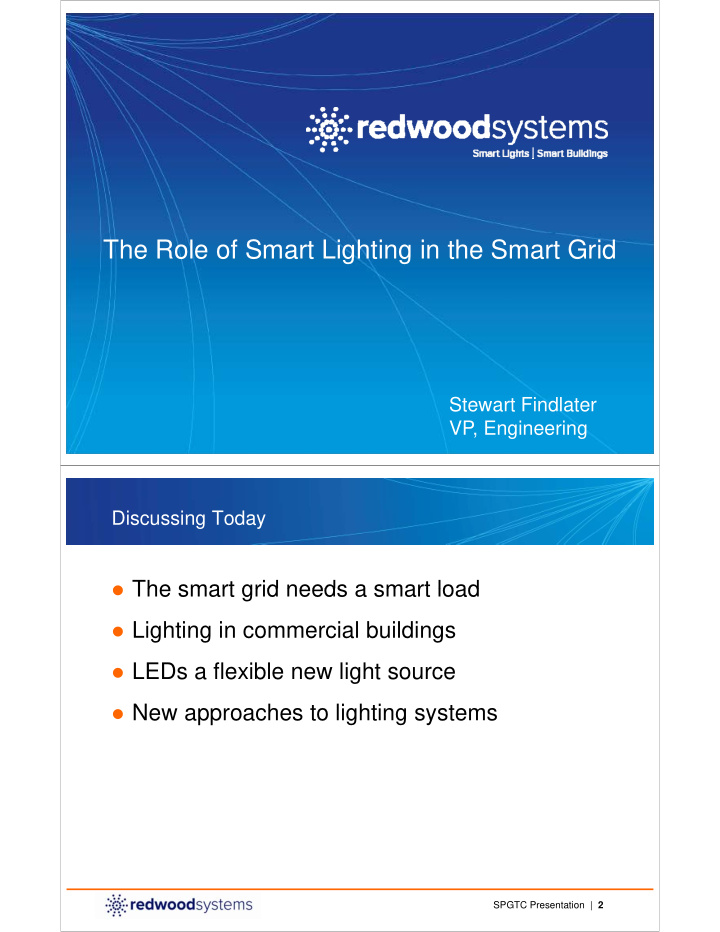



The Role of Smart Lighting in the Smart Grid St Stewart Findlater t Fi dl t VP, Engineering Discussing Today The smart grid needs a smart load The smart grid needs a smart load Lighting in commercial buildings LEDs a flexible new light source New approaches to lighting systems SPGTC Presentation | 2
Smart Grid SPGTC Presentation | 3 Impacts of U. S. Building on Resources 40% primary energy use 72% electricity consumption* 72% electricity consumption 39% of CO 2 emissions *US Dept of Energy, EIA 2008 Annual Energy Outlook SPGTC Presentation | 4
Use of Electricity in Commercial Buildings 38% 13% 13% 12% 12% 5% 4% 2% 2% 1% Source: Energy Information Administration, Annual SPGTC Presentation | 5 Energy Review, Table 8.9 (June 2008) Lighting and The Smart Grid The lighting system in a The lighting system in a commercial building… Accounts for more than 1/3 Accounts for more than 1/3 of all electricity usage Is the only major load that Is the only major load that can be dynamically shifted Is one of the most cost- Is one of the most cost- effective, energy efficiency projects that can be done Can be accurately measured SPGTC Presentation | 6
Lighting and the Smart Grid Achieving these benefits requires: Achieving these benefits requires: an intelligent lighting system, and a better light source. SPGTC Presentation | 7 Basic Benefits of LED Lights Approaching most efficient A hi t ffi i t light source Lower heat output Very long life (50,000 hrs) y g ( , ) Environmentally rugged (no breakage mercury) breakage, mercury) Improved light quality Start instantly, inherently dimmable in efficient ways SPGTC Presentation | 8
LED introduction “LEDs - the third significant lighting invention since fire ” – Forbes Magazine At 130 lumens / watt, LEDs have now surpassed all other sources Commercial Interior Options for LEDs 2x2s & 2x4s Maxlite Lunera 2200 Cree Axis MLFP2X235 Lunera 5400 Albeo C-Series LR24, CR24 LEDs Linear Lightwild Ledalite Architectural Albeo Richter 4” and 8’ Lunera 6400 Jump Lighting tracks, ACDC USAI Philips Omega MP- Monopoints Philips Lightolier Beta ownlights, d task Focal Point Alva Alva Zumtobel Zumtobel Do an L Lucifer if Wila USAI Task Slot Sconces
LED Lighting – Happening Faster Than You Think **Source: Philips Lighting PRIVATE AND CONFIDENTIAL | 11 Types of Controls Wall switches and dimmers Fixture scale Timers & Lighting Control Panels Occupancy detection Daylighting systems Daylighting systems Zone scale Wall / scene control Addressable fixtures Advanced lighting systems Building scale Building Automation Systems Building Automation Systems SPGTC Presentation | 12
Conventional Controls Conventional junction box junction box ballast ballast Control Features photocell 1 Electrical Panel sensor occupancy 2 Fluorescent light sensor fixture fixture 2 1 light switch Hard to scale Deployed as “overlays” to power Complex commissioning and C l i i i d Dimmable ballasts and challenging to use/update per-fixture addressability add costs Principally components with p y p Varying degrees of BMS integration limited/zero extensibility SPGTC Presentation | 13 For The Rest of Us: The ‘Last’ Analog Dinosaur? When were these bulbs made? Are they on/off? Are they working? e t ey o g How much power are they using? What temperature are they? ? How much light are they emitting? What is their color temperature and color rendering? When are they going to fail? Where is the problem in this system? Where is the problem in this system? SPGTC Presentation | 14
Re-Envisioning LED Lighting LEDs are digital LEDs need low voltage LEDs need low voltage DC power Today, we run high voltage AC to LED g drivers… SPGTC Presentation | 15 Centralized DC power, control, and network architecture • Redwood Engines power and control li ht lights with two-way communications ith t i ti to each fixture • Replaces all AC wiring from panel • Replaces all AC wiring from panel with networking or low voltage cabling enabling faster, lower cost installs
Installation: Standard Lighting vs. Networked Lighting Driver Driver Sensor Sensor High density sensor network • Redwood Adaptors at each fixture detect light occupancy temperature detect light, occupancy, temperature and power levels
Building intelligence and lighting control platform • Platform of HW, SW, Sensors, Light Adapters - 20mm x 1mm; Profiles fixture; Senses motion, task light, volumetric light, room temp, Networking, Apps, APIs Networking Apps APIs , g , g , p, LED temp, voltage/current; Auto-discovery • Flexible, scalable, extensible The End. Thank you! 20
Recommend
More recommend